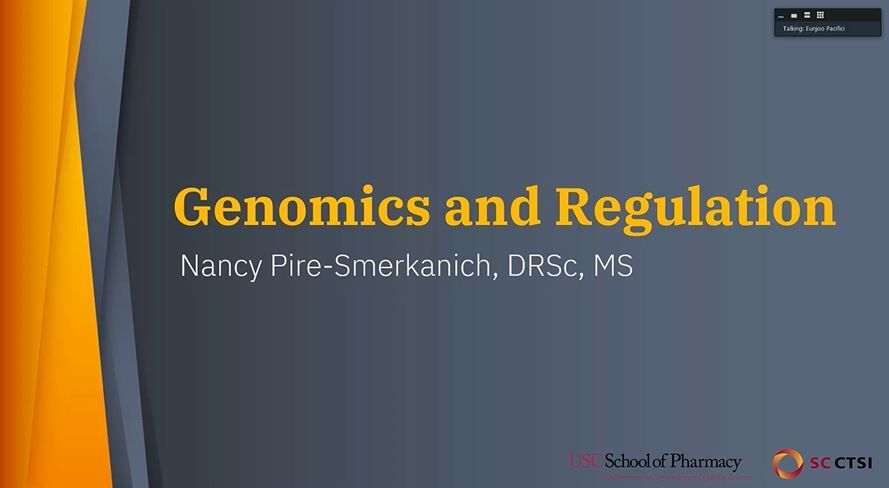Definitions
- Genomics
- The branch of molecular biology concerned with the structure, function, evolution, and mapping of genomes
- Genomics is usually talked about in the personalized medicine space, but the more accurate term is precision medicine
- Personalized or Precision Medicine
- Genomics is usually talked about in the personalized medicine space, but the more accurate term is precision medicine
- Genotype
- What makes us individuals
- Genomic Biomarker
- The technology piece, the piece that is continuing to emerge and helps us understand id the interventions we are developing have therapeutic potential
- Right medicine, right dose, right person
- Pharmacogenomics (PGx)
- The study of how an individual’s entire genetic makeup determines the body’s response to drugs
- Pharmacogenetics (PGt)
- The study of how sequence variation within specific candidate genes affects an individual’s drug responses
The Testing We Will Be Talking About
- In vitro diagnostic (IVD) products
- Example: Stool samples, blood lab work, urine tests, salvia
- Not just the diagnosis of the disease, but used to determine the overall state of health
Regulatory Authority
- IVDs are medical devices as defined by Federal Food, Drug, and Cosmetic Act
- Subject to premarket and post-market controls
- Regulated on the amount of risk each device poses
- Subject to categorization under the Clinical Laboratory Improvement Amendments of 1988
- Subject to premarket and post-market controls
Genetic Testing
- Different Types of IVD Testing
- IVDs that are marketed to directly to considers without involvement of a health care provider
- Generally, require the consumer to self-collect
- Used to be much rarer than they are now, but this field is heavily expanding (i.e. 23andMe)
- DCT Testing
- Direct-to-consumer testing (DCT)
- Varying levels of support data/evidence to support claims of DCT
- Some DCTs are reviewed while others are not
- General wellness, non-medical, or low risk DCTs tests are not reviewed by FDA but those for moderate to high-risk medical purposes are
- DCT Genetic Testing
- FDA Review is based on
- Analytical validity – How do you do the test?
- i. Example: cystic fibrosis, sickle cell
- Clinical validity – Can the test do what it sought out to do?
- Claims – What a company says about their test and how well it works
- Analytical validity – How do you do the test?
- FDA Review is based on
- IVDs that are marketed to directly to considers without involvement of a health care provider
Regulatory Pathway(s)
- Carrier Screening Tests
- Can be done on a healthy person to see if there is some type of disease that can be passed on
- Ex. Cystic fibroses or Sickle cell disease
- Exempt from FDA premarket review
- Can be done on a healthy person to see if there is some type of disease that can be passed on
- Genetic Health Risk (GHR) Tests
- Provide information on an individual’s genetic risk for a certain medical decision
- Require FDA clearance
- Cancer Predisposition Tests
- Subject to pre-market review and clearance
- Tests provide information on the risk of getting a certain type of cancer
- Pharmacogenetic Tests
- Provide information regarding the role genetic may play in an individual’s reaction to drug
- Can help determine patient groups for certain drugs
- Need premarket review and clearance
Proprietary/Specialized Genetic Testing – Biomarkers
- Biomarker – something that can be objectively measured and is a sign of a normal/abnormal process, or a condition, or disease
- Molecule found in the tissue, blood, bodily fluids, etc.
- A biomarker is a genetic signature or “fingerprint” – a pattern of activity in a set of genes that reveals some biological condition
- Using the tools that we have (i.e. biomarkers) how to get products out of discovery and into the clinic
- Question from the audience:
- Regarding carrier screening test, can you clarify if there's logic behind why these tests would be exempt from premarket review is if it's a risk-based criteria take X sickle cell etc. seems pretty high risk to me?
- Response
- Having those conditions is where the risk comes in. The tests are done on healthy people and labeled with a caveat that the results of this test have their own disclaimer and direct you to discuss the results with a healthcare professional. They (products like 23andME) are just mean to be identifiers.
Guidance for Biomarkers (US)
- FDA Guidance for Biomarkers in the US
- FDA E16 (2011)
- Describes recommendations are: Context (of use), structure and format of regulatory submission for qualification (Ref: ICH E15)
- Notes that “qualification” is a conclusion
- FDA E16 (2011)
- Generated by CDER and CBER
- Talks about context of use a lot and what FDA want to see in the submission you provide about the biomarker
Guidance for Biomarker s/ PGx and PGtData (EU)
- ICH Topic E15[EMEA 2007]:
- What are the definitions for: genomic biomarkers, pharmacogenomics, pharmacogenetics, genomic data, and sample coding categories
- Harmonized how we are actually coding the samples and their associated data
- Coding becomes an issue with big data sets – this is helpful for these situations and provides standardization
- CH E15 reflects EU Priority re: Confidentiality and Privacy
- Tractability for data that has anonymized CH E15 reflects EU Priority re: Confidentiality and Privacy
- Coded data or samples can be single or double coded
Biomarker Development
- How do I get information together to ensure I have a qualified biomarker?
- This is all based on this Biomarker Qualification: Evidentiary Framework
- Needs Assessment à Context of Use à Benefit à Evidence to support qualifications
- This is all based on this Biomarker Qualification: Evidentiary Framework
- Biomarker Validation Approach
Biomarker based CT designs
- How does this manifest it when we use biomarkers in our clinical trials?
- Different usage : inclusion criteria or exclusion criteria
Biomarkers vs. Companion Diagnostics
- How are companion diagnostic tests different from biomarkers?
- A companion diagnostic test is essentially a biomarker test that enables better decision making on the use of a therapy.
- It is a diagnostic test that is specifically linked to a therapeutic drug many companies seeing the values in this
- Helps clinicians treat their patients better
Biomarkers as CoDx
- Have to start the development early in the drug development process
In Vitro/Companion Diagnostics
- Talks about the patient population and how the treatment for these patients would change depending on their biomarkers
- The FDA issued final guidance “ In Vitro Companion Diagnostic Devices” Aug. 2014
Companion Diagnostics
- How to deal with test negative vs. test positive population and what kind of analytics can be performed on them
- When a clinical trial is properly designed to establish the safety and effectiveness of a therapeutic product in a population based on measurement or detection of a (bio)marker, the results of the clinical trial can also be used to establish the clinical validity of the IVD companion diagnostic
The translational potential of complex disease genomics
- Genomics can be used in various aspects according to the circle
- FDA report from 2013 surrounding personalized medicine
- Describes the (still) evolving regulatory processes in response to scientific developments that are critical for the development of personalized therapeutics and diagnostics and how to bridge developments in genomics and other relevant sciences to clinical practice by advancing the tools necessary for evaluating targeted therapeutics and bringing them to market more efficiently
- Case Study: Kalydeco (ivacaftor) for cystic fibrosis
- Approved Jan 2021 for patients with G551D genetic mutation
Personalized Medicine
- Individual medicine, precision medicine, stratified medicine, P4 medicine
- Personalized medicine can be used at all stages: Prevention, Diagnosis, Treatment
- Considers personalized medicine as the umbrella with other (i.e. Individual medicine, precision medicine, stratified medicine, P4 medicine) fields under it
- Can debate this – peers may have other views
The Innovation to Translational Science
- Talks about how we come up with the ideas of how we can translate things and then we eventually resolve the issues and discover how they can be applied in a clinical sense

